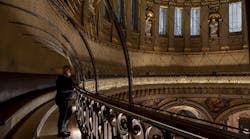Europe’s lighting industry association is calling on the European Commission to make ultraviolet C-band (UV-C) disinfection part of the broad buildings renovation policy that is itself a key element in the EC’s Green Deal to achieve carbon neutrality and improve health and quality of life by 2050.
UV-C is radiation typically ranging from 200‒280 nm, which is a shorter wavelength than UV-A (315‒400 nm) and UV-B (280‒315 nm). It has been proven to deactivate or eradicate a number of pathogens, including the virus that causes COVID-19.
Ultraviolet is invisible, but typically comes from light sources such as mercury vapor lamps, LEDs, the Sun, and others so it is often referred to as “light.” A 254-nm mercury vapor lamp eradicated 99% of SARS-CoV-2, commonly called the coronavirus, in a laboratory test earlier this year.
Lighting vendors including Signify, Osram, and others are ramping up production of conventional mercury lamps for coronavirus disinfection purposes. Some vendors are pursuing LED UV-C variations.
LightingEurope, the Brussels-based trade body representing the industry, is now calling on the EC to include UV-C in Renovation Wave, a cornerstone policy within the European Green Deal proposed by the EC last December and adopted by the European Parliament in January.
The trade group wants to elevate the role of UV-C from specialty disinfection and germicidal applications — such as in medical settings and water treatment — to more general settings. Many possible uses are in order, such as fitting UV-C into air circulation systems in commercial and public buildings, among a host of others, where “it can provide significant benefits to combat COVID-19,’’ the association said in a press release.
“Our challenge is to switch regulators’ perception of UV-C beyond special applications to mass market solutions for buildings and transport, where the concentration of human activity raises the risk of contamination,” said LightingEurope president Lionel Brunet. “As LightingEurope, we have the responsibility to engage in UV-C as part of our actions to renovate lighting. Our aim is to educate authorities and the market on the industry guidelines and standards already in place and to promote the uptake of UV-C solutions.”
UV-C comes with a huge caution that it is hazardous to skin and eyes, so safety measures are in order. LightingEurope said it “fully supports the publications of the Global Lighting Association on this topic: UV-C Safety Guidelines providing guidance on the safe use of UV-C products and Germicidal UV-C Irradiation: Sources, Products and Applications with an overview of the applications of UV-C disinfection technologies.”
Through Renovation Wave, the EC aims to enliven what it says is a decarbonization and renovation rate of a mere 1% in European buildings. The EC states that “roughly 75% of the building stock is energy inefficient, yet almost 80% of today’s buildings will still be in use in 2050.”
Earlier this month, LightingEurope and other building-and-energy associations wrote to EC officials including president Ursula Von der Leyen expressing concerns over delays in Renovation Wave, and offering help in rolling it out.
The EC plans to outline more details and an “action plan” for Renovation Wave in October.
Not only is renovation needed to support climate goals through low carbon technologies, but it should also be a key driver of growth, the EC says.
“Renovation is a major opportunity for economic growth as it provides jobs and boosts the construction sector, which is largely dominated by local businesses, while strengthening Europe’s industrial competitiveness,” the EC said in a recent statement on Renovation Wave. “Building renovation is therefore central to the post-COVID-19 economic recovery, and was specifically referred to in the recovery plan published by the European Commission on 27 May 2020.”
The EC’s proposed €750 billion “repair and recovery” plan, called Next Generation EU, is a budgetary proposal aimed at lifting Europe from ravages of the health pandemic. By comparison, the Renovation Wave is a policy objective which could draw on funds provided by Next Generation EU or other EU budgetary sources.
“LightingEurope is advocating for the Next Generation EU Recovery Plan to finance renovation activities across Europe, and more specifically to finance the full renovation of luminaires to introduce LED lighting in combination with some controls/sensors and smartness potential, and the uptake of UV-C disinfection technologies,” LightingEurope secretary general Ourania Georgoutsakou told LEDs Magazine. It is applying the same principles to Renovation Wave.
The UK’s Lighting Industry Association is also pushing the EC to make smart lighting part of the €750B post-pandemic recovery proposal.
MARK HALPER is a contributing editor for LEDs Magazine, and an energy, technology, and business journalist ([email protected]).
For up-to-the-minute LED and SSL updates, why not follow us on Twitter? You’ll find curated content and commentary, as well as information on industry events, webcasts, and surveys on our LinkedIn Company Page and our Facebook page.





